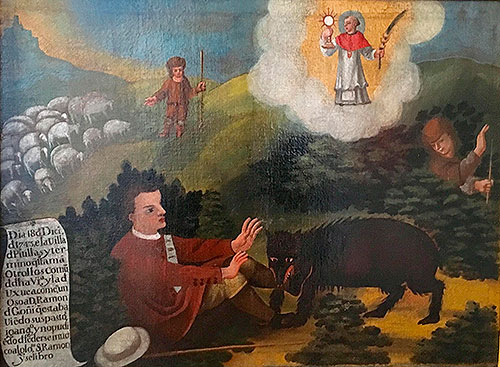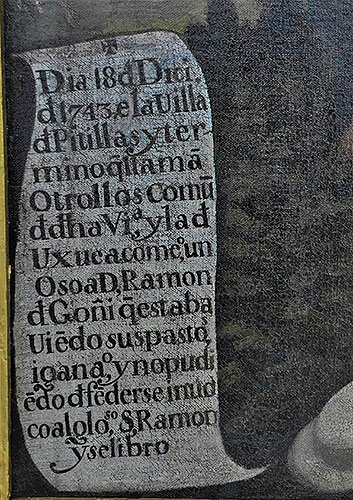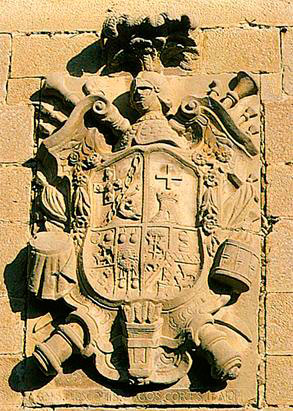The piece of the month of February 2019
A CURIOUS VOTIVE OFFERING OF 1743 WITH A BEAR IN PITILLAS
Ricardo Fernández Gracia
Chair of Navarrese Heritage and Art
University of Navarra
In 2017, in a press article (Diario de Navarra, March 3, 2017, pp. 64-65), we gave an account of twenty-nine painted votive offerings, preserved in Navarra. The news made that, from some localities, several people pointed out to us the existence of others, generally in private collections. To date we have located and photographed thirty-three. The list may grow, although we fear that it will not be very long. Among our informants, Don Íñigo Pérez de Rada kindly provided us with the photograph of a very curious one, belonging to his private collection and whose protagonist is one of his paternal relatives. In the painting we find Ramón de Goñi, who was about to perish before a bear in the town of Pitillas, in the month of December of 1743.
Before going on to its study and analysis, we will remember that the Latin expression ex voto refers to the fulfillment of a vow made to the divinity or supernatural being for some favor received, by means of a wax figure, crutches, clothes, letters, weapons, decorations... etc., or with the painted expression of the fact or prodigy. His goal was to thank and perpetuate in the report of families and collectives the event, contributing to magnify the fame of the intercessor, generating emotions and reactions in those who contemplated it. As Freedberg has written, the fact of making a promise to an image, in moments of desperation, implied a commitment, on the one hand, and hopes, on the other, in a direct relationship between the solution of the problem and the creation of the icon, as well as the conviction that gratitude would come in this way.
Painting
The painted ex-voto, now in the private collection mentioned above, was until a century ago in the ancestral home of the Goñi family in Pitillas, and later moved to Lodosa. It is an oil painting on canvas, whose medium dimensions are adapted to what is usual in this subject of works; in this case, its measurements are 73 x cms.

Votive offering of Don Ramón de Goñi, harassed by a bear and asking for protection
of Saint Ramón Nonato. 1743. Private Collection of Íñigo Pérez de Rada.
The composition presents, in different planes, the history to which reference letter makes a cartouche in the lower left part in which we read: "+ Día 18 dici. / d(e) 1743 e(n) la Uilla / d(e) Pitillas y ter- / mino q(ue) llama(n) / Otrollos comu(n) dha Viª y la d(e) / Uxue acomeº un / Oso a D. Ramon / d(e) Goñi q(ue) estaba/ uiendo sus pastos / i ganaº, y no pudi / e(n)do d(e)fenderse inuo- / co al gloso S. Ramon / y se libro".... Following this script and story, we find in the foreground the aforementioned gentleman with his elegant coat and hat and cane on the ground. He appears seated on the ground and trying to shoo away with his hands a bear that has already bitten his left leg. In a later shot, among the vegetation of some bushes, a shepherd with a stick seems between frightened and willing to help the assaulted. The upper part is divided in two. On the left we see in the distance the sanctuary of Ujué and on its hills a flock of sheep with its shepherd, wearing a fur cap, and on the right, within a celestial cloud, the figure of Saint Ramón Nonato with the habit of a Mercedarian and cardinal's moustache, holding the monstrance in one hand, while with the other he holds the palm of triumph with three crowns, allusive to his condition of virgin, eloquent preacher and of having undergone great sufferings. His presence in the ex-voto may be related to the protagonist of the story, named Ramón, and his devotion to him by the usual patronages of St. Ramón on pregnant women and newborns. However, it should also be related to the protection of the Mercedarian saint over livestock and land, given that the saint was dedicated by his father, in his youth, to shepherding in order to keep him away from his religious vocation.

registration of the ex-voto of Don Ramón de Goñi being harassed by a bear
and asking for the protection of Saint Ramón Nonato. 1743.
Private Collection of Íñigo Pérez de Rada.
In addition, it is necessary to point out the particular cult to San Ramón Nonato in the parish of Pitillas, evidenced by its altarpiece, datable around 1730 and possibly due to the munificence of Don Ramón de Goñi. It contains in its only body a painting that seems a little earlier, similar in its iconographic content to those found in the parishes of Lodosa, Andosilla or Roncal. It is of Aragonese filiation, not far from the workshop of Francisco del Plano (1658-1739), with several works in Navarra. sample the saint kneeling with the padlock in his mouth, the usual palm with the three crowns, the shackles and a ring with its chain on the ground. St. Raymond contemplates the vision of Christ and the Virgin placing the crown of pink thorns on him, respectively, alluding to a mystical vision he experienced. In the foreground, a pair of captives with the scapulars of Mercy are added, the one closest to the viewer with the Catalan barretina. In the background, a small scene narrates, in the form of a vignette, his birth, which gives the saint his nickname for having extracted his body from the womb of his mother, already dead, by performing a cesarean section.
As it usually happens in this subject of paintings, the quality is average, but their anthropological interest together with the internship disappearance of the same, make them objects of great importance for the study of the past. As for the authorship, we can not make any assumption because its popular style does not match the easel masters that we know in the second third of the eighteenth century. An intervention on the piece carried out in late 2018 and early this year has reintegrated some parts of the clothing of the protagonist of the scene, as well as the bushes of the landscape, while fixing the pigment throughout the painting.
The protagonist: Mr. Ramón de Goñi y Jaurrieta
Don Ramón de Goñi y Jaurrieta (1705-1786) was born and died in Pitillas, he belonged to a branch of the Goñi lineage that, from Peralta, settled in Pitillas around 1700, when his father Isidoro Antonio de Goñi married Juana Jaurrieta, a native of Pitillas. He was born on August 6, 1705, married Francisca de Ubago, from Falces (†1741), in January 1738 and died on August 26, 1786, after dictating his will before the notary of Olite, Antonio Lasala. His son Ramón de Goñi y Ubago (1741-1813) litigated before the Royal Courts for the placement of the noble coat of arms on the manor house of Pitillas, in 1779. The sentence was favorable to the use of the coat of arms since Don Ramón demonstrated that he was a descendant of the house of the Goñi de Peralta, where they were considered noble and noble sons. In the great ancestral home, the coat of arms with his two surnames (Goñi, Ubago) and those of his wife (Cortés, Bayona) are still preserved.

Heraldic coat of arms of the Goñi de Pitillas ancestral home (1779),
with the arms of Goñi-Ubago-Cortés-Bayona.
Both father and son held positions in the mesta in Pitillas and had cattle as their main source of income source . Several judicial processes preserved in the file General of Navarre attest to this. In them they defend the passage of their flocks through different cattle tracks, some leases of herbs, as well as the quality of their sheep. In February of 1743, Don Ramón de Goñi y Jaurrieta presented the annual accounts of Pitillas, since he had been depositary of the same one throughout the preceding year.
Of the event narrated in the ex-voto we have not found other written testimonies. In the 2017 Pitillas Festival program, in a box in a few brief lines, a legend of the event is included, assuming that it happened in 1683 and that the bear had escaped from the fences of Olite, extremes that do not agree with either the chronology of the event or with the time of its protagonist. However, the fact that it is recorded, at degree scroll as a legend, leads us to believe that it was transmitted by oral sources and possibly also in some written ones, although distorting or confusing the chronology. In the will of Don Ramón de Goñi y Jaurrieta, to which we have made reference letter lines before and notarized in Pitillas on August 21, 1786, the matter is not mentioned either, although it gives us some interesting data . As it used to happen, the date of the will is only a few days away from the date of death. Don Ramón declared that he was ill, although in his right mind and firm report. His universal heir was his son Ramón Goñi y Ubago. He left special bequests to his grandchildren Miguel, Ramón, Javiera and María Luisa. Likewise, he arranged for the celebration of numerous masses in Pitillas and the Franciscans of Olite, and alms for the basilicas of Nuestra Señora del Portal of Villafranca, Santo Domingo and San Bartolomé of Pitillas, Santa Brígida of Olite and other charitable institutions. His brother, the presbyter Don Francisco de Goñi, would be his executor.
The bear
The event narrated in the ex-voto is the only one, among those that we have catalogued in Navarre, allusive to an animal that attacks a man and this one is freed by the intercession of a saint. It is not less exceptional that the animal is a bear, in those latitudes of the foral geography. In this respect, we must point out, following Elosegi's monograph, that the bear was hunted and its capture rewarded in northern towns of the foral geography, according to different documents of the XVIII century of Leiza, Espinal, Ochagavía and Isaba, always protected by the legislation of the Courts of Navarre that, in 1734, had established the amounts to be paid to the hunters. However, the author points out that, in previous centuries, particularly in the Middle Ages average, the presence of the brown bear was common in most of the mountain massifs of the peninsula. In 1850, Madoz located the presence of the animal in the Roncal and Salazar valleys.
In addition to the marked presence of the animal in such southern latitudes, the date of December, when the bear should be hibernating, which could indicate a delayed winter in terms of climate, is also strange. In this regard, it should be taken into account that the entrance in the bear cave depended a lot on the area and the harshness of the winter, and bears have been described that have not hibernated in areas that are not very harsh. As food was scarce in a month like December, it is possible that the bear went down from the nearby foothills of the Sierra de Ujué to look for food in areas closer to populated areas.
SOURCES AND BIBLIOGRAPHY
file Parish of Pitillas. Book of Wakes and Deceased, 1678-1793.
file General of Navarre. Processes and Notarial Protocols of Olite. Antonio Lasala. 1786 and Juan José Moreno de Vega. 1743.
Family tree of the Goñi family (Peralta-Pitillas) by Ramón Sáinz de los Terreros, courtesy of Íñigo Pérez de Rada.
Program of the San Ramón de Pitillas Festivities, 2017, kindly shown to us by Doña Covadonga Anaut, to whom we express our gratitude.
ELOSEGI IRURTIA, M. M., El oso pardo en los Pirineos, Barcelona, Lynx Edicions, 2009.
IRIGOYEN, M., "Nobility and coat of arms of the Goñi descendants", Euskal-Erria: revista bascongada San Sebastián, T. 67 (2º semester 1912), pp. 31-33.
ZURIAGA SENENT, V. F., La imagen devocional de Nuestra Señora de la Merced, Tradición, training, Continuidad y Variantes, Valencia, Universitat de Valencia Servei de Publicacions, 2005.
